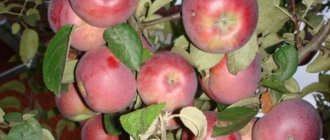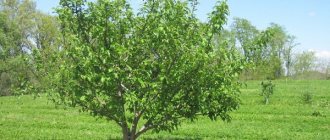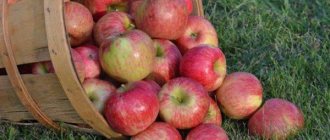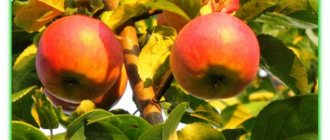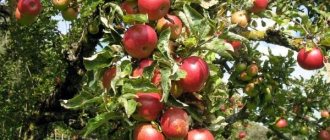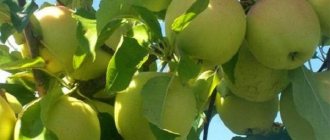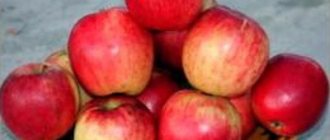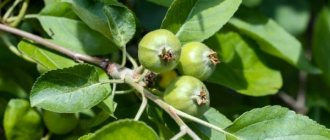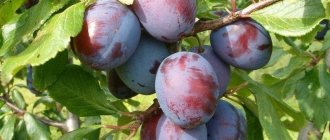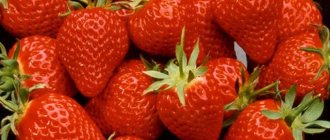Description of the McIntosh apple tree variety
There are more and more new varieties in the State Register every year, but there are also those that have remained at the peak of popularity among gardeners for many years. One of these foreign varieties is McIntosh, which, thanks to its high yield, unpretentiousness to growing conditions, taste and aroma of the fruit, has earned the love and respect of gardeners around the world.
Apples: size, color, weight
McIntosh fruits are usually medium-sized or medium-large (145-210 grams). They are located randomly on the tree, and can be of completely different sizes. Most often, apples are conical, round in shape, slightly flattened at the top and ribbed at the bottom. The skin on them is very smooth, glossy, and has a predominantly white-green and yellow-green tint. At maturity, it is covered with a streaked purple blush on a bright red background by 85-90%. The skin is quite tough and can be easily removed from the flesh. The chemical composition is characterized by the following indicators per 100 grams of product:
- P-active substances – 196 milligrams.
- Ascorbic acid (vitamin C) – 3.8 milligrams.
- Total sugars (fructose) – 10.8%.
- Pectins (fiber) – 10.7%.
- Titratable acids – 0.57%.
The pulp of apples is predominantly white, but sometimes may have reddish or pink streaks. It is very juicy, tender, crispy, has a pronounced sweet and sour taste and a powerful aroma, and smells like candy. In appearance, the fruits are rated 4.8 out of five, and in taste they score all 5.
Apple tree McIntosh: characteristics
Crown and root system
This tree is considered medium-sized, although if you do not prune it at all, you can get quite large specimens up to 5-6 meters, and in exceptional cases up to all 8. However, most gardeners do not allow Mackintosh to grow so large.
The crown shape of the variety is usually pyramidal, which is considered its main distinguishing feature. Over the years, it becomes spreading, medium-dense, occupying an area of approximately 4-5 meters. The shoots of apple trees are usually thin or medium thick, with gray or grayish-brown bark. The leaves are medium-sized, rounded, smoothly textured, with a smooth and slightly jagged edge, light green in color. The McIntosh root system has thick skeletal roots, as well as many second- and third-order branches. Typically, young thin roots are covered with a network of so-called hairs, which have one purpose - they “look for” and absorb moisture.
Productivity and pollination
No periodicity in the fruiting of these apple trees was observed, but they can reduce their productivity under unfavorable weather conditions.
On average, a harvest of at least 180-200 kilograms can be harvested from one mature tree. However, there are officially registered results of 300-350 kilograms , although these are isolated cases.
It is believed that the McIntosh variety is a self-fertile variety, therefore it does not require special pollinators. However, experienced gardeners say that by alternately planting varieties suitable for the flowering period, higher yields can be achieved.
Winter hardiness and disease resistance
The variety is characterized by average resistance to frost, so it cannot be grown throughout our country. At approximately -20-25°C, the fruit shoots of apple trees already begin to freeze and the ovaries crumble, which cannot but negatively affect the number of fruits harvested next year.
The McIntosh variety does not show any special resistance to common apple diseases. It is equally susceptible to powdery mildew and scab, and is readily spoiled by codling moths and green aphids. However, it responds very well to preventive measures. If you promptly and regularly clean the tree trunk area from fallen leaves and fruits and spray it with natural and chemical agents, you can avoid almost any problems.
Macintosh computers, or Mac for short, produced by the American mega-corporation Apple, got their name thanks to this particular variety of apple. However, by the time of their invention, the name of the variety had already been patented, so the producers decided to slightly change the spelling, leaving the name still quite recognizable. As everyone knows, the company's logo is a bitten apple.
Subspecies and rootstocks
Many different subspecies of the McIntosh variety have been developed using rootstocks.
| Subspecies | Description |
| Mackintosh's daughter | This winter subspecies was grown by domestic pomologists in the Oryol region by crossing it with the Kulon-Kitayka variety. It is particularly frost-resistant, as it was bred specifically for harsh climates. At the same time, the trees produce fairly high yields of apples with enviable keeping quality. The fruits are slightly smaller, barely reaching 160 grams, and have a greenish skin color with a red blush. |
| American | This is a low-growing crop, which belongs to the late-autumn crop, grown on a dwarf rootstock. The outer blush of these apples is bright scarlet in color. But the main advantage of the fruit is its truly powerful vitamin composition. It is this subspecies that is often used to make baby food. |
| Columnar | The Mackintosh species, obtained by chance, is distinguished by a characteristic structure - a powerful central trunk and an almost complete absence of lateral skeletal branches. The apples are usually medium in size, distinguished by a dark burgundy blush, and are not inferior in taste to the original variety. This type of tree allows you to save time on harvesting, as well as carry out various maintenance activities. However, there is also a drawback - a short life expectancy. On average, a columnar Mackintosh lives and bears fruit for 11-15 years, after which it will have to be replaced with young trees. |
| Black | This is the most frost-resistant, late-ripening variety, grown on a semi-dwarf rootstock, the fruits from which are harvested only at the end of October. It is particularly resistant to lack of moisture and requires virtually no watering. Apples are green in color with a dark purple blush. They are stored very well and have high transport characteristics. They are sweeter than other subspecies and the main variety. |
| Cortland | The subspecies was developed in New York in 1898 through selection by Mackintosh and Ben Davis. At the beginning of the 15th century, the apple tree was brought to Russia, where it took root very well, as it belongs to a late ripening period, is distinguished by its bright red-orange color, as well as high shelf life. The main disadvantage of the species is considered to be low resistance to apple diseases and scab in particular. |
Description, photo
McIntosh apple tree is a popular fall variety. The fruit crop has an interesting history. The apple tree was not obtained by breeders through crossing, but was simply found in a Canadian garden.
So, in the 18th century, farmer John Mackintosh, when purchasing a plot, discovered several apple tree seedlings. During transplantation, all the fruit crops died, but one seedling still took root and lived with regular fruiting for more than 100 years.
The apple tree so impressed gardeners with its longevity and good productivity that the variety named after its discoverer, McIntosh, has spread beyond Canada.
History of variety development
The foreign variety McIntosh, or Mekintosh, is one of the autumn varieties. The history of its breeding is interesting. A fruit crop, as is rarely the case, is not the result of the work of breeders or the crossing of several varieties.
This variety was discovered by accident; this event occurred back in the 18th century. In 1796, farmer Mekintosh bought a plot of land in Ontario and found several young apple trees on it. After transplantation, the only tree survived. It produced apples every year, and its lifespan exceeded 100 years.
It was this unique apple tree that became the progenitor of the new variety. First it spread to Canada, and then it was brought to other countries of the New World, and then crossed the ocean and ended up in Europe, reaching Russia. The culture was named Mackintosh after the name of its discoverer.
additional characteristics
To familiarize yourself with the advantages and disadvantages of the variety, you should familiarize yourself with additional characteristics.
Advantages and disadvantages
The apple tree undoubtedly gained popularity due to its advantages, which include:
- Durability of fruiting;
- High-quality, dessert taste of fruits;
- Good transportability;
- Average winter hardiness.
You should know! Although the apple tree is classified as a medium-winter-hardy variety, some gardeners dispute this, arguing that the apple tree has high frost resistance.
disadvantages of the fruit crop:
- Decrease in yield;
- Low resistance to powdery mildew and scab;
- Uneven ripening of fruits.
Main differences
A distinctive feature of the apple tree is the pyramidal shape of the crown, which resembles a cypress. On spreading, brown branches there is wide foliage, yellow-green in color. The fruits on the tree are arranged in a chaotic manner, with different sizes and shades.
Mackintosh is two years old.
Dimensions of an adult tree
The fruit crop is medium-sized, with an annual growth of no more than 8 cm. An adult tree is 5-6 m in height. In exceptional cases, the plant reaches 7-8 m.
Apple tree McIntosh.
Productivity
The apple tree is characterized by a decrease in yield in an unfavorable year without periodicity in fruiting. On average, the fruits weigh 150–200 g . are harvested from one tree . But isolated cases were recorded when a harvest of 350 kg was harvested from a fruit crop.
Tasting assessment
Apples have a compressed oval shape with a ribbed surface. The pulp is juicy, fine-grained, with a sweet-candy taste. According to the tasting assessment, the fruits are rated 5 points.
Fruits of the McIntosh apple tree.
Winter hardiness
The variety is moderately winter-hardy. At low temperatures of 20 degrees in winter, the fruit shoots of the apple tree freeze over. Which subsequently affects productivity.
Disease resistance
The apple tree is susceptible to the most common fungal diseases - powdery mildew and scab. Also the main pests are aphids and codling moths.
Advice! Timely treatment of wood can prevent diseases and control pests.
See what the McIntosh apple tree looks like in the video below:
Possible difficulties during cultivation
One of the disadvantages of the McIntosh variety is that these trees have weak immunity and are often attacked by infections and pests. Most often, the reason for this fact is improper care of the crop or lack of regular preventive measures. But in any case, to successfully eliminate difficulties, you need to know the signs of an apple tree being affected by diseases and pests, as well as the basic methods of treatment.
A list of the main diseases and pests of the McIntosh variety is presented below:
- Scab. The disease manifests itself as brown spots on the leaves of the apple tree, which subsequently lead to drying of the green mass. Black spots form on the apples, the fruit cracks and rots, becoming unsuitable for storage and use. Apple scab is treated with fungicides (for example, Fitosporin).
- Powdery mildew. This disease affects leaves and inflorescences. The first sign is a white powdery coating on some parts of the tree, which visually resembles flour. Infected leaves and shoots dry out, as a result of which the apple tree partially loses its ability to photosynthesize and begins to wither. At the same time, the inflorescences fall off and the crop yield decreases. To treat the disease, the affected leaves are removed, and the tree crown is treated with fungicides (for example, “Chorus”).
- Fruit rot (moniliosis). The source of infection is fungal spores that overwinter on plant debris in the upper layers of the soil. A symptom of fruit rot is brown spots on apples. Over time, they increase in size, the fruits become deformed and rot. To get rid of the disease, you need to remove and destroy the affected fruits, and treat the apple tree with a solution of antifungal drugs (for example, “Homom”).
- Aphid. Insects appear on tree leaves with the onset of warm weather and suck the juice out of them, causing the green mass to wither. Aphids are located in small groups on the lower surface of the leaf and cover it with a sticky coating. Against pests, use a soap solution or insecticides (for example, “Karbofos”), spraying them on the crown of the apple tree.
- Apple mite. The larvae of this insect eat the leaves of the tree, and the adults suck the juice from the apple tree and cause its death. The spread of the pest is facilitated by the thickening of the crown and lack of sunlight. You can get rid of the mite by spraying the affected trees with an infusion of onion peels or insecticides (for example, Iskra).
To prevent the occurrence of the listed infections and pests, it is recommended to take the following preventive measures:
- plant seedlings in areas that receive sufficient sunlight throughout the day;
- regularly inspect apple trees to detect problems at an early stage;
- in autumn and spring, dig up the soil in the tree trunk circle to destroy insect larvae and fungal spores;
- spray the tree crown with an aqueous solution of soap or Nitrafen until the buds open, before and after flowering to protect against pests;
- to protect against fungal infections, spray apple trees in spring with a 1% solution of Bordeaux mixture;
- carry out formative pruning in a timely manner in order to eliminate excessive crown density.
Reviews
Victoria. Izhevsk. “I can say the following about the McIntosh variety; in general, the apple tree suits me. The apples are quite juicy, with a characteristic dessert taste. Fruiting is regular, the number of fruits reaches 80 kg. from one tree. The only drawback of the variety: the leaves and fruits are severely affected by scab. Wood requires constant care and treatment with chemicals.”
Samoilova. E. S. Krasnodar region. "Good day. The McIntosh apple tree has lived on our property for over 25 years. The apple tree pleases us every year with its abundance of harvest. The fruits are juicy, sweet, aromatic, and have a very beautiful presentation. My apples are the most popular at the market; buyers snap them up with a bang. Caring for fruit crops is simple; it only involves pruning and watering during droughts.”
Hope. Orel. “Several varieties of apple trees grow in my garden plot. Compared to other fruit crops, the McIntosh apple tree variety is the best in terms of yield. The apples are medium in size, but the tree is all covered with fruit. Due to the high shelf life of apples, we use them fresh until March. These fruits also make excellent preserves, jams and compotes.”
Features of planting and care
Landing dates
Apple trees are planted in early spring before buds open or in autumn 1 month before the first frost.
Dig a hole at the rate of 60 cm deep and 100 cm wide. Humus from leaves is placed at the bottom and humus and peat are added in equal proportions. A peg is dug into the hole and a seedling is installed.
Having tied the tree to a support, it is buried in soil, compacted and watered generously with 3 buckets of water.
Important! When planting, take into account a distance of 2 cm of the root collar above the soil level.
Watch the video on how to plant an apple tree in spring:
Agricultural technology
Regular feeding with fertilizers will allow the tree to quickly form and begin to bear fruit early. Every year you should mulch the tree trunk circle with nitrogen-phosphorus fertilizers.
Nitrogen and mineral fertilizers are applied once every three years. To ensure that the apple tree has enough nutrients, you should regularly weed the weeds around the circular area of the trunk.
Weed the tree trunk circle.
Pruning and crown formation
The first pruning is carried out immediately after planting the seedling. The branches are cut so that they are located 5 cm below the main conductor. Then, for several years in a row, all the blossoms are cut off from the apple tree and the buds are cut off, so that the main lateral branches actively grow and develop.
Apple tree pruning diagram.
Watch a video tutorial on pruning and crown shaping:
Pollinator varieties
The fruit crop is self-fertile. But for better fruit set, cross-pollination with other autumn varieties of apple trees is necessary.
Watch a video describing the most popular autumn varieties of apple trees:
Features of growing Borovinka
Landing
Key Features
- Both sunny and shady areas are suitable for planting. It doesn't make much difference where it grows; it easily tolerates shade from taller trees.
- The soil should have a low acidity level. If there is no suitable one, you can “quench” it with lime. The variety takes root well on loam and black soil, but it will also grow without problems in sandy soil, fertilized correctly.
- Holes for planting are prepared in advance, at least 2-3 weeks in advance. Dig holes 70 centimeters deep and 1 meter in diameter. Part of the soil is mixed with fertilizers and returned back, filled with 20-30 liters of water.
- Drainage is laid at the bottom of the hole. Gravel, broken bricks and even nutshells are suitable. A layer of 10-15 centimeters is enough.
- On the north side, stakes are dug in to secure the seedling. They cannot be removed for 3 years.
- Before planting, the tree can be immersed in a bucket of cool water for 4-6 hours so that the roots are saturated with moisture.
- The seedlings are sprinkled with earth, trampling it well, but not compacting it too much. After planting, it is customary to water them with 20-40 liters of water.
Particular attention should be paid to the height of the root collar. For a boletus, it is optimal for it to protrude 20-30 centimeters above the ground surface
Disembarkation dates
It is optimal to plant two or three year old seedlings in open ground. It is permissible to do this in the spring before the buds open, somewhere in early or mid-April. But you can plant Borovinka in the fall after the leaves have fallen. The main thing is that there are at least 3-4 weeks left before the onset of frost.
Protection from frost and rodents
To protect tender young seedlings from frost, it is necessary to carry out a set of measures to prepare them. First of all, this concerns watering, which must be stopped at least 4 weeks before the first frost. Otherwise, the tree will not have time to prepare and the movement of sap in the trunk can lead to frostbite and death. The easiest way is to cover the trunk circle with spruce branches, sheaves of straw or hay, but you can wrap it with foam rubber, roofing felt or roofing felt.
You can protect the bark of young apple trees from damage by pests using regular whitewashing with lime in the fall. The trunk and several lower skeletal branches are whitened. Lubricating the trunks with rendered lard or grease and treating them with suitable “chemistry” helps against rodents.
Tree care
Loosening the soil, watering: proper agricultural technology
Like any apple tree, Borovinka loves airy, but nutrient-rich soil. Therefore, you regularly need to loosen the soil around the trunk. At the same time, it won’t hurt to remove root shoots, shoots of other shrubs and trees, and pull out weeds.
Trees of this variety are difficult to tolerate during dry periods. Therefore, when the weather becomes rainless, it is necessary to water them regularly, once a week, with 30-40 liters of water. It is optimal to do this in 2 approaches: morning and evening. It is recommended to additionally mulch the tree trunk circle, for example, with chopped grass or manure, humus. This will help retain moisture longer and prevent weed germination.
Pruning: simple crown formation
The first formative pruning is done immediately after planting. The main trunk is cut by exactly one third, and the skeletal branches are made 5-7 centimeters shorter. Make sure not to remove more than a third of all branches of the apple tree at one time, otherwise it may get sick from stress and even die. In the future, every year in the fall or spring it will be necessary to regularly thin out the crown, which is prone to thickening, removing excess shoots.
Sanitary pruning involves removing all damaged, diseased or dead branches. In this case, it is advisable to immediately coat the cut areas with water-based paint or garden varnish. Make sure that during pruning, the movement of sap in the trunk either has not yet begun or has already stopped.
Features of ripening and fruiting
The apple tree differs from other varieties in its characteristics during fruiting.
Important! McIntosh fruits have excellent keeping quality and transportability, thanks to which the variety has become famous in different regions of Russia.
Fruiting
Start
In order for the apple tree to have large fruits and stability in the harvest, gardeners do not advise allowing the first fruiting to occur before 6–7 years after planting the seedling.
Mackintosh bears fruit from 6-7 years.
Peculiarities
After the first fruiting, the number of fruit branches should be controlled. To avoid a decline in yield, carefully remove a large accumulation of buds and cut off the branches by 1/3.
Deadlines
Blooms
The first flowering begins in the 2nd year of the tree's in early May.
Maturation
The apple tree is characterized by uneven fruit ripening . To avoid apples falling off the tree, the harvest is harvested from late August to early October.
McIntosh apples are harvested from August to October.
Storage
The fruits ripen within 3 weeks after harvest. At a temperature of plus 5 - 10 degrees, apples retain their taste and consumer qualities for 3 - 4 months. If you lower the temperature to 0 - 3 degrees, the fruits will last up to 6 - 7 months.
McIntosh fruits can be stored for up to 6-7 months.
Storage and transportation
McIntosh apples are known far beyond the borders of their growth, all thanks to the excellent keeping quality of the fruit.
The main time for harvesting apples of this variety is the second half of September, but they ripen very unevenly. In summer cottages and personal gardens, fruits begin to be picked in the month of August, and are completed, weather permitting, at the beginning of October. Without creating special conditions, apples can be stored until December, and their consumer ripeness occurs 2 weeks after harvest. This means that you can pick apples, put them in your apartment and enjoy them almost until the new year. But if you want to save them until spring, you need to create conditions under which the ripening process of the picked fruits will be inhibited, that is, you need to store the apples at a low temperature.
Place McIntosh apples (from a regular or columnar apple tree) in wooden or plywood boxes in layers with the stems up, sprinkle them thoroughly with sand or sawdust so that the fruits are not visible. You can store them without sand, but then you need to wrap each apple in a sheet of paper.
They are transported over short distances in boxes without sawdust, but this is dangerous - when moving, the apples can be damaged and therefore rot. It is best to deliver the fruits to the place of consumption, processing or sale in boxes sprinkled with sawdust. By the way, sawdust does not need to be taken from coniferous wood; its strong smell will overwhelm the delicate aroma of apples.
Other varieties with the word McIntosh in the name
The McIntosh apple tree has all the indicators for propagation by rootstocks and the cultivation of new fruit crops.
Daughter Mackintosh
The Daughter McIntosh apple tree was bred by Russian breeders in 1969 by crossing McIntosh and Kulon - Kitayka. Winter ripening variety. The first yield occurs 5 years after planting.
The fruits are green, with a red blurred blush. Apples are regularly rounded. The pulp is juicy, tender, with a sweet and sour taste. The tree is medium-sized with a wide-rounded crown.
Mackintosh's daughter.
The advantages of the apple tree include:
- Frost resistance;
- Good yield;
- Taste qualities of fruits;
- Long-term storage of apples.
A disadvantage is considered to be the lack of immunity to scab.
You should know! The variety Mackintosh's Daughter was bred for the Moscow region.
Black Mackintosh
a late-autumn, frost-resistant variety. The tree is medium-sized with a spreading crown. Fruiting of the fruit crop begins at the 4th year of life.
Mackintosh Black.
Apples with a symmetrical shape are yellow-green with purple stripes. The pulp is juicy and has a sweet-sour taste. The fruits have an average weight of 100 - 200 g. The advantages of the apple tree include good drought resistance.
Cortland
In 1898, in New York, by crossing the McIntosh and Ben Davis varieties, the McIntosh Cortland apple tree was bred. Since 1915, the fruit crop was zoned to Russia . Late ripening apple tree The fruits are slightly elongated, weighing 80–110 g. The tree is vigorous with a voluminous, spreading crown.
The variety is not resistant to scab, which leads to a decrease in yield.
McIntosh Cortland.
American
Fruit crop American Mackentosh - fruit ripening period The tree is low-growing with a rounded crown. Apples are bright red in color with juicy and sweet flesh. The variety has a dessert taste of fruits with a high content of vitamins.
The plant is often subject to fungal diseases and pests.
American Mackentosh.
Columnar
When rootstocked to a columnar crop, the McIntosh apple tree looks like a straight trunk without spreading lateral branches.
The fruits are located along the trunk on small fruit twigs.
Advantages of the rootstock:
- Saving space in the garden;
- Decorative look;
- Fast fruiting;
- Taste qualities of fruits.
The small size of the columnar rootstock is convenient for harvesting.
Important! The lifespan of the fruit crop is short; after 13 years the apple tree will need to be replaced.
Apple tree McIntosh: cultural features
Advantages and disadvantages.
The McIntosh apple tree variety has become popular for its advantages . These include: the tree bears fruit for a long time; McIntosh apples have high-quality dessert taste properties; fruits are well transported; winter resistance is at an average level.
Despite the fact that the McIntosh apple tree is a crop with an average level of winter resistance, some gardeners are willing to argue with this, they claim that the variety has a high level of frost resistance.
Cons: the yield rate is reduced; poor immunity to scab and powdery mildew; McIntosh apples do not ripen at the same time.
Distinctive features of the tree.
The crown of the McIntosh apple tree is in the form of a pyramid, reminiscent of a cypress. The branches are spreading, brown in color, with wide yellow-green leaves on them. The apples are arranged chaotically, they are of different sizes and different colors.
The size of an adult apple tree.
Mackintosh apple tree: photo of variety
The McIntosh apple tree is a tree of medium vigor, growing eight cm every year. An adult apple tree grows up to five to six meters high. In some cases, the tree can reach seven to eight meters.
Yield indicator.
The McIntosh apple tree reduces the yield in certain unfavorable seasons, but there is no periodic productivity. The average weight of apples is one hundred fifty to two hundred grams. Up to two hundred grams of fruit are harvested from one apple tree. However, there were also record holders when three hundred and fifty kilos of fruit were obtained from the trees.
Tasting assessment.
McIntosh apples are compressed, oval-shaped, the surface is ribbed. The internal contents of apples are juicy, fine grained, and have a sweet, candy-like taste. The tasting score was five out of five.
Winter resistance.
The McIntosh apple tree variety has an average level of resistance to the winter season. In winter, at low temperature conditions of twenty degrees, the tree's fruit branches freeze. This further affects the yield.
Immunity to diseases.
The McIntosh apple tree is not immune to the most popular fungal infections, such as powdery mildew and scab. Harmful insects that attack the variety are aphids and codling moths.
If you treat the apple tree in time, you can avoid disease and get rid of parasites.
Growing in different regions
In outskirts of Moscow
To grow the McIntosh variety in the Moscow region, several factors should be taken into account. Since the fruit crop is moderately frost-resistant, care should be taken to cover the tree before the winter period.
In summer soil drought is not allowed ; for this purpose, regular watering is carried out. If you don’t have time to care for your apple tree, it is recommended to plant an analogue of the McIntosh’s Daughter variety for this region.
In the Volga region
In the Volga region, both soil and climatic conditions are suitable for growing the Mackintosh fruit crop . With proper care and timely pruning, the apple tree will regularly produce tasty fruits. The only thing to watch out for in this region is the attack of aphids on the plant.
In the Volga region, Mackintosh grows well and bears fruit.
In Ukraine
To grow the McIntosh variety in Ukraine, you should constantly inspect the tree for fungal diseases . Since winters in this region have little snow, it is necessary to insulate the root system with compost in the autumn. By performing these simple tasks, the apple tree will not only take root well, but will also produce a stable harvest.
Planting a crop
The secret to properly designing a plot of land: fertilizer is applied to the soil, the correct period for planting is selected, and after the seedling has taken root, regular feeding is carried out.
Drop off rules:
- the distance between seedlings is at least 40 cm, otherwise the tree will not have room to grow;
- row width is not less than 2 m;
- the soil around the seedling is constantly loosened - such measures are carried out separately or as part of watering and fertilizing the soil;
- fertilizing and replenishment are calculated according to growth - you cannot use the same soil fertilization scheme all year round.
The apple tree does not tolerate long-term frosts, so a protected area is selected. A low area that collects stagnant water from throughout the garden is not suitable.
Apple trees need sunlight
The shade adversely affects the condition of the fruits: they will be sour and deformed.
The composition of the soil must be balanced. If clay predominates, several additional buckets of sand are added. Do the same with sandy soil - clay is added to the upper layers.
Landing dates
The best time for planting is early spring or autumn. If the first option is chosen, then you need to wait until the upper layers of the soil warm up. Blooming buds on neighboring crops indicate that the favorable moment for planting a seedling has been missed.
Autumn planting is carried out a month before the first frost. If the soil has time to freeze, the seedling will not be accepted. It is better to do replanting in the summer. Such activities are carried out only with young trees and if there is a threat to the crop - poor soil composition, frequent flooding of the land.
Land processing
The chosen site affects the quality of the future harvest. Before planting the crop, the soil is further enriched. It is more convenient to fertilize immediately after creating the planting hole. All work to replenish the soil is carried out 2-3 weeks before the day of the planned planting. The depth of the pit should be at least 70 cm, taking into account the applied fertilizers.
Disembarkation procedure
A nutrient mixture is added to each cavity. It consists of manure or compost. It is useful to apply nitrogen fertilizers - you will need no more than 70 g of them for each hole. If the land plot has high soil acidity, dolomite flour is added. It will create the correct alkaline balance of the soil.
Manure is applied in a thick layer and left in the pit until the crop is planted. Before this, the dried soil is watered abundantly. A peg is driven in next to the seedling.
The rhizome is carefully buried and compacted with fresh soil. The seedling is watered from above with three buckets of purified water. A roller of soil is created around the trunk. It will retain excess moisture and protect the root part from contamination.
